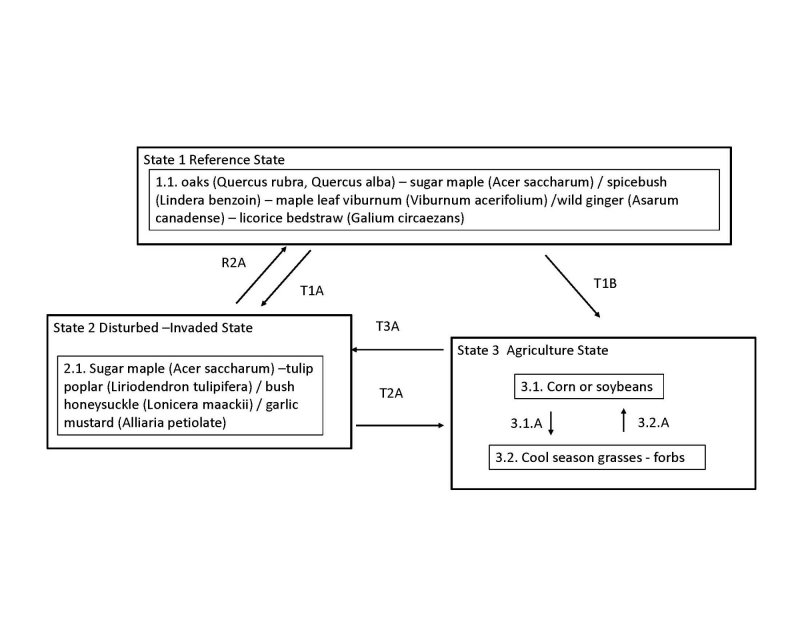
Natural Resources
Conservation Service
Ecological site F114XA102IN
Lacustrine Terrace Forest
Last updated: 9/26/2024
Accessed: 11/23/2024
General information
Provisional. A provisional ecological site description has undergone quality control and quality assurance review. It contains a working state and transition model and enough information to identify the ecological site.
MLRA notes
Major Land Resource Area (MLRA): 114X–Southern Illinois and Indiana Thin Loess and Till Plain
Overview of the MLRAMLRA 114 makes up about 4,550 square miles (11,795 square kilometers. The three parts of this MRLA are mostly in the Till Plains Section of the Central Lowland Province of the Interior Plains. The western third of the western part is in the Highland Rim Section of the Interior Low Plateaus Province of the Interior Plains. The eastern half of the eastern part is in the Kanawha Section of the Appalachian Plateaus Province of the Appalachian Highlands.
Both large and small tributaries of the Ohio River dissect the nearly level to very steep glaciated uplands in this area. The major streams and rivers have well defined valleys with broad flood plains and numerous stream terraces. The flood plains along the smaller streams are narrow. Broad summits are nearly level to gently sloping. Elevation ranges from 320 feet (100 meters) on the southernmost flood plain along the Ohio River to 1,250 feet (380 meters) on the highest ridges. Local relief is mainly 10 to 50 feet (3 to 15 meters), but it can be 50 to 100 feet (15 to 30 meters) along drainageways and streams. Also, the Ohio River bluffs are as much as 300 feet (90 meters) above the river valley floor.
Classification relationships
US Forest Service EcoRegion: 222 Eastern Broadleaf Forest (Continental) Province
Homoya's Natural Regions of Indiana: Bluegrass Region
The following NatureServe Explorer Ecological System has a high level of probability to match the ecological site found on these soils. Field verification and ESD development is needed prior to using this information for conservation planning and/or restoration initiatives: South-Central Interior Mesophytic Forest CES 202.887.
Ecological site concept
The Sloping Lacustrine Forest site is found on sloping lacustrine soils and are a mesic hardwood forest with a substantial oak component. Species include sugar maple, northern red oak, American beech, sugar maple, white oak, tulip tree, white ash, and basswood. Understory vegetation density and composition will depend on canopy cover, micro-topography, and disturbance regime and may vary from site to site. The high-quality sites will exhibit a diverse array of native herbaceous species including numerous spring wildflowers. Understory herbaceous and shrub species present in examples of this system can vary. Stands dense tree cover have less shrub and herbaceous species while stand with more open tree canopy cover will tend to have a dense understory. The most abundant component of the shrub layer is often samplings of canopy trees.
Associated sites
| F114XA101IN |
Wet Lacustrine Forest Wet Lacustrine Forest. These sites are very poorly drained to somewhat poorly drained. |
|---|
Similar sites
| F114XA501IN |
Wet Till Flatwoods Wet Till Forest. These sites are on till plains and share many similar species. |
|---|
Table 1. Dominant plant species
| Tree |
(1) Quercus rubra |
|---|---|
| Shrub |
(1) Viburnum acerifolium |
| Herbaceous |
(1) Asarum canadense |
Click on box and path labels to scroll to the respective text.
Ecosystem states
| T1A | - | Invasive plant establishment and increase. |
|---|---|---|
| T1B | - | Clearing; brush removal; site preparation; tillage; seeding; weed control |
| R2A | - | Brush removal; weed control; tree planting; timber stand improvement practices |
| T2A | - | Tree/brush removal; weed control; site preparation; tillage and seeding; continuous management inputs. |
| T3A | - | No management inputs; abandonment. |
State 1 submodel, plant communities
State 2 submodel, plant communities
State 3 submodel, plant communities
| 3.1.A | - | Seeding; weed control; grassland management |
|---|---|---|
| 3.2.A | - | Site preparation; tillage; seeding; cropland management |

